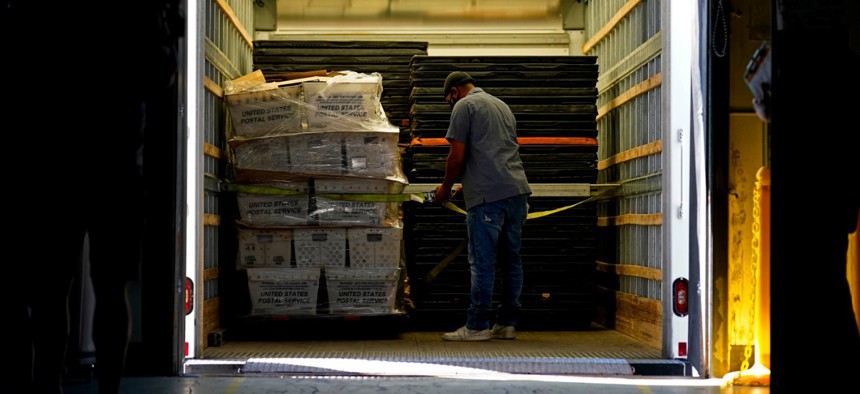
Absentee ballots are loaded onto a truck for mailing at the Wake County Board of Elections as preparation for the upcoming election are ongoing in Raleigh, N.C., Thursday, Sept. 3, 2020. Gerry Broome/AP
Amid Firestorm, USPS Launches TV and Direct Mail Campaign to Assuage Concerns About Mail-In Voting
Postal Service will seek to reach all voters through a variety of media.
The U.S. Postal Service is launching an advertising campaign that will include sending mailings to educate Americans on the requirements for voting by mail, the agency told stakeholders in a recent meeting.
USPS, facing significant backlash for mail delays that could endanger the timeliness of what promises to be an unprecedented flood of mailed-in ballots for the Nov. 3 presidential election due to the novel coronavirus pandemic, told attendees of its first election mail task force meeting last week that it would launch the ads on TV, radio, print and direct mail to residential customers. The ads follow President Trump's months-long criticism of states that have encouraged voting by mail and widespread frustration that USPS has not adequately supported the expansion of mail-in voting.
The campaign will run through Election Day, according to Dave Partenheimer, a USPS spokesman, to “educate the public on the Postal Service’s role within the mail-in voting process.”
“The non-partisan campaign neither encourages nor discourages mail-in voting, rather it is designed to reach and inform all voters about the importance of planning ahead if they plan to vote by mail,” Partenheimer said. He declined to elaborate on the cost of the ad buy.
The Postal Service has faced particular criticism after it warned nearly all states their deadlines for ballot delivery would risk disenfranchising voters due to the mailing agency’s schedule. State officials and federal lawmakers also raised concerns that ballots sent out using the cheaper bulk marketing designation would not automatically be expedited as first-class mail, as is typical in election years. Embattled Postmaster General Louis DeJoy has since promised USPS would in fact expedite election mail and make additional truck routes, overtime and other resources available as necessary.
Still, changes DeJoy has implemented to emphasize that all facets of USPS operations proceed on a set schedule—even if that requires leaving mail behind for the next day—have caused significant delivery delays. Slides prepared for DeJoy on Aug. 12 made public by House Democrats show on-time delivery declining by between 8% and 10% across the Postal Service’s mail offerings. The Postal Service later released data proactively that showed on-time performance starting to rebound in mid-August.
While DeJoy has promised 95% of all election mail will be delivered in a one-to-three day window, many stakeholders remain concerned that ongoing delays will cause USPS to deliver ballots to election boards after Election Day. A recent Postal Service inspector general report found several issues with the agency’s handling of election mail that could negatively impact on-time ballot delivery. USPS will soon be forced to release more data publicly on mail delays thanks to a recent ruling by the Postal Regulatory Commission, and the agency also said it would make more of the data available to Congress.
Delays to mail delivery writ large could cause ballots to arrive later than expected, but the surge of mailed ballots is unlikely itself to significantly impact postal operations. Election mail will likely make up just 1%-2% of the Postal Service’s deliveries in the coming months.
At last week’s task force meeting, postal management detailed internal steps it has taken to prepare for the election—including its outreach to boards of elections across the country—and its new plans to message externally. Officials also asked postal union and management association leaders for suggestions in how to ease election mail delivery going forward, which they all agreed to do.
“A lot of what they have in place is education,” said Brian Wagner, president of the National Association of Postal Supervisors and a task force member. He added USPS had established a “very good, coordinated effort” to ensure a smooth election process.
The Postal Service is currently running an ad seeking to calm worried voters, telling them the agency can bring “peace of mind” by ensuring “your ballot is on its way.”
DeJoy, who is now facing allegations that prior to taking his current position he pressured employees at his private sector company to donate to Repubilcan candidates and later reimbursed them illegally, sought to deflect from the onslaught of criticism he has faced since he took office in June.
“The meeting reaffirmed my faith that the Postal Service is fully ready, willing and committed to deliver the nation’s election mail timely and securely,” DeJoy said, “and our organization is completely aligned on fulfilling our important role in the democratic process.”







